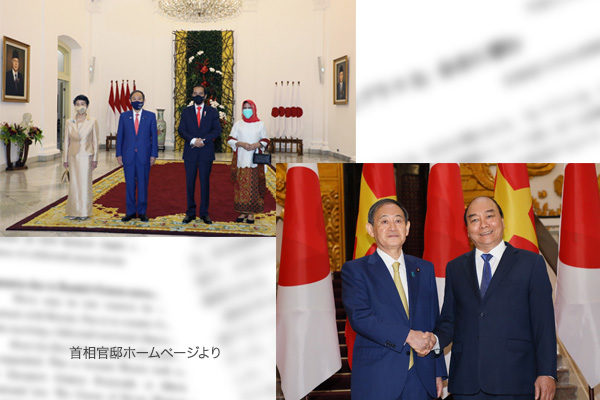During his Southeast Asian tour last week, Japanese Prime Minister Yoshihide Suga consistently advocated a “free and open Indo-Pacific” with China in mind. On the way paved by his predecessor Shinzo Abe, Suga kept the quadrilateral security dialogue, or the Quad, between Japan, the United States, Australia and India moving and used his first overseas tour since his inauguration as prime minister in September to enhance Japan’s partnership with the core members of the Association of Southeast Asian Nations. Unless China’s Xi Jinping regime stops its blatant coercive diplomacy towards neighbors, the four countries will seek to expand the Quad framework to form a “soft alliance.”
Suga enhanced partnership through SE Asian tour
Suga, though being not as gorgeous as Abe, steadily completed his first overseas trip as prime minister. He toured Vietnam, the current ASEAN chair, and Southeast Asian leader Indonesia at just the right moment following the Quad foreign ministers meeting in Tokyo in early October. Chinese Foreign Minister Wang Yi during his visit to Malaysia on October 13 denounced the Tokyo meeting as representing an attempt to build the Indo-Pacific version of the North Atlantic Treaty Organization. Before Suga’s tour of Vietnam and Indonesia, the Chinese minister might have attempted to warn ASEAN not to be lured into a Quad-plus framework.
China is concerned that an expanded Quad might develop into a “hard alliance” like NATO, where an armed attack on one of the NATO members is considered an attack against all, in order to isolate China. In fact, Suga during the two-nation tour emphasized that countries in the vast region covering the two oceans should seek their loose partnership and prosperity based on the rule of law, respect for national sovereignty, free market and other common values.
Suga might have considered ASEAN’s more moderate “Outlook on the Indo-Pacific” that replaced “free” of the Japan-advocated “free and open Indo-Pacific” with “inclusive” and was announced in June 2019. The Japanese and ASEAN initiatives should be combined to go in the same direction. The combination might be difficult under the acute American way of thinking. Japan can take advantage of its long contacts with ASEAN to play a role in combining two initiatives.
Noting that the Japanese and ASEAN Indo-Pacific initiatives have many fundamental commonalities, Suga in his speech in Hanoi said: “Unfortunately, in this region, developments contrary to the rule of law and openness upheld by the ASEAN Outlook have been unfolding in the South China Sea. Japan is strongly opposed to any actions that escalate tensions in the South China Sea.” He thus warned against China that has ignored international rules. Then, Suga agreed with Vietnam to transfer Japanese defense equipment technologies to Vietnam and enhance supply chains for medical and other essential goods in a mutually complementary way.
Washington seeking flexible alliance
The Quad foreign ministers meeting in Tokyo agreed on a loose strategic union thanks to China’s recent aggressive expansionism. Particularly, India, plagued with a military standoff with China in the border area, has invited Australia as well as Japan and the U.S. to participate in November’s Malabar naval exercises, achieving the first quadrilateral military drill in history.
A U.S. initiative to build a soft alliance in the Indo-Pacific region will make concrete progress when U.S. Secretary of State Mike Pompeo and Defense Secretary Mark Esper visit India in late October. Ironically, whether the Quad would develop from a consultation body into a new multilateral security framework including Southeast Asian and European countries will depend on the aggressiveness of China’s expansionism.
Hiroshi Yuasa is a Planning Committee member and a senior fellow at the Japan Institute for National Fundamentals. He is a columnist for the Sankei Shimbun newspaper.


